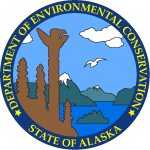| Action Date |
Action |
Description |
DEC Staff |
| 10/2/1992 |
Update or Other Action |
State Elmendorf Environmental Restoration Agreement signed. The agreement is designed to remedy environmental contamination due to past practices at the Base and avoid the expense of formal enforcement proceedings. The Air Force will perform any necessary assessment, monitoring, remediation, and closure of the sites. The agreement addresses the following program areas: solid waste, underground storage tanks (USTs), and petroleum oil and lubricants (POL) spills.
LUST sites will be remediated pursuant to 18 AAC 78, POL sites will be remediated pursuant to 18 AAC 75 (non-LUST petroleum); the interim soil guidance for non-UST soil cleanup levels dated July 17, 1991; the guidance for storage, remediation and disposal of non-UST petroleum contaminated soils date July 29, 1991; and for water, the applicable water standards set out in 18 AAC 70; and the applicable federal regulatory requirements for Maximum Contaminant Levels for drinking water; and interim guidance for surface and groundwater cleanups, dated September 26, 1990.
ADEC and USAF agree to review new ADEC guidance within sixty (60) days of its formal adoption. The parties agree to incorporate new guidance into future remediation actions. If the Air Force wishes to reduce soil and water contamination levels to those which exceed the previous mentioned regulations/criteria, it may prepare a risk assessment which sets forth justification for the proposed elevated cleanup levels. Solid waste sites will be remediated pursuant to the levels identified in 18 AAC 60.315 and 18 AAC 60.035(4). |
Louis Howard |
| 10/4/1994 |
Update or Other Action |
Elmendorf has initiated temporary closure at Air Force UST Identification Number (AFID) 130. Based on the field investigation, UST 130 is a 4,600-gallon, carbon steel, underground storage tank UST 130 is located in the south-central portion of the Base approximately 85 feet northwest of the intersection of Second and P Street. The UST was installed January 10, 1965 and was used to store gasoline. UST 130 is reportedly located adjacent to three other USTs. The UST is currently in place; however, it is inactive and does not contain any product.
As part of the site assessment, two borings were installed near the UST. Field screening was conducted continuously during placement of the soil borings with a photoionization detector to monitor organic vapors.
Soil samples were collected from each boring and analyzed at an analy1ical laboratory.
The results of the site assessment indicate gasoline range organic concentrations in the soil which exceed the cleanup levels developed for this site based on ADEC's guidelines. This indicates that petroleum contamination (as defined by ADEC) resulting from the storage of gasoline in UST 130 does exist. |
John Halverson |
| 11/17/1994 |
Site Added to Database |
|
Former Staff |
| 11/17/1994 |
Leaking Underground Storage Tank Release Confirmed - Petroleum |
LUST Site created in CSP for source area ID 76438 ADD; Site added to database. Spill report taken by John Halverson. Gasoline UST 130 southeast of bldg. 1-836. GRO sample was detected in soil at 160 mg/kg. |
Louis Howard |
| 12/2/1994 |
Update or Other Action |
NOR; DEC received notice of release and responded with confirmation letter. The Air Force and State of Alaska have entered into compliance agreements for UST management, closure, and corrective action. In accordance with the UST Compliance Agreement, a draft site assessment report must be submitted to the department within sixty (60) days after submittal of the samples to the laboratory. As noted in the agreement, initial abatement activities outlined in 18 AAC 78.230 are to be conducted prior to transfer of leaking UST sites into the SERA. Corrective action associated with the leaks or spills from regulated USTs will be conducted pursuant to the SERA. In order to do this the Air Force must provide amendments to the SERA attachments, identifying the sites to be added and a schedule for conducting the corrective actions. Releases from the tank must be cleaned up in accordance with 18 AAC 78, the UST compliance agreement and the State Elemendorf Environmental Restoration Agreement. The Air Force may conduct future cleanup under SERA if the site is added to the agreement by amending the attachments. |
John Halverson |
| 12/31/1994 |
Update or Other Action |
Final Site Assessment Report for UST no. 130. UST 130 is located in the south - central portion of the Base approximately 300 ft. southeast of bldg. 1-836 (Kenai Dining Hall) and approximately 85 ft. northwest of the intersection of P Street and Second Street. UST 130 was used to store gasoline as part of a former service station and had a 12,000 gallon capacity. Nearest downgradient water supply well is Base Well 52 approximately 3,800 ft. away. Sample from 14-15.5 ft. bgs was taken because it was within 2 ft. of the bottom of the UST piping. Gasoline range organics (GRO) was detected at 160 mg/kg. It was recommended that the Air Force undertake steps to further quantify the area of contamination that exceeds the cleanup levels. Based on the results of the release investigation, it can more accurately determine the need for site remediation. |
Louis Howard |
| 1/19/1995 |
Update or Other Action |
OU5 Groundwater (GW) Modeling Report received. The objectives of the modeling task were to: Evaluate the movement of contaminants across Elmendorf AFB (EAFB) and within Operable Unit (OU) 5; Predict migration over the next 30 years; and Determine if selected receptor points along Ship Creek and an unnamed beaver pond will be impacted. A 3 dimensional finite element model (SALT) was selected because of its versatility in handling complex geology and boundary conditions. It was modified to improve the program's efficiency, to include contaminant decay and site specific boundary conditions along Ship Creek. This revision was called SALT 3 consists of GW flow and contaminant transport models. The hydrogeology of the modeled area was evaluated using lithologic data collected from all available boreholes within the modeled area and water level data collected from shallow water table monitoring wells in March and September 1993.
After a review of the data from September 1993 GW sampling and available OU 1, 2, and SERA site data, benzene and trichloroethene (TCE) were selected as representative compounds due to their potential health impacts. Concentrations in the recharge over the water table was set to zero except for at source areas. Since improvement in soil quality is expected over time, the sources were assumed to cease contributing benzene and TCE to GW after 5 years. All levels in the recharge zone were set to zero at the end of the first 5 years.
The conclusions show benzene and TCE will migrate toward the south and decline over time. Because of infiltration, there may be some localized areas that experience a temporary increase in level as a "pulse" migrates toward the south. Benzene will be detectable in GW for over 20 years, however, the levels in GW basewide should be below the MCL after 15 years (1993-2008). TCE levels will be detectable in GW after 30 years (2023) and should be less than the MCL basewide after 20 years (2013). |
Louis Howard |
| 4/21/1995 |
Update or Other Action |
Air Force Memorandum to John Halverson re: UST meeting. Elmendorf AFB will accomplish the following actions regarding UST projects. These actions are based upon conversation between, John Mahaffey, Larry Opperman and yourself.
1) EAFB will make every effort to accomplish clean closure of a UST removal if possible. 2) UST removal locations requiring cleanup action will be transferred into the State Elmendorf Environmental Restoration Agreement (SERA). A list of sites requiring cleanup will be coordinated with your office. 3) The presumptive remedy for contaminated UST sites in the outwash plain only will be bioventing technolgy. 4) Contaminated soils exceeding cleanup levels may be placed back into the excavation only if the site assessment (SA) indicates a need for further action. 5) Contaminated UST sites not in the outwash plain will require further investigation to determine appropriate cleanup options. 6) We (Elmendorf) will make every attempt possible to assure new USTs or new aboveground tanks are not installed in any way that would hamper future access for cleanup. 7) The project will first accomplish removal of all the USTs. SA information will be used to prioritize sites for cleanup using existing project funds. Additional funding will be requested to complete cleanup if available. Sites not addressed for cleanup due to exhausted funding will be placed in SERA Phase IV.
John Halverson signed memorandum on April 21, 1995. Memorandum submitted by Douglas G. Tarbett, Maj. USAF, Chief Environmental Compliance (CCs 3 WG/JA and 3 SPTG/CE). |
Louis Howard |
| 9/30/1996 |
Underground Storage Tank Site Characterization or Assessment |
UST 130 Site Assessment Report received. UST 130 was located in the southern portion of Elmendorf Air Force Base, near the intersection of Second and P streets, and near Building 1-836. The 12,000-galion-capacity UST was installed in 1965 to provide MOGAS for a former fuel station. UST 130 was removed on July 27,1996. Potentially contaminated soil excavated during removal of the UST was temporarily stockpiled at the site and removed for thermal desorption following USAF authorization.
Soil samples were collected from the site for field screening and laboratory analyses during the
site assessment. Field screening with a photoionization detector indicated that stockpiled soil
and soil at the limits of the excavation were potentially contaminated with petroleum
hydrocarbons. Soil samples were collected from both the excavation limits and stockpiled soil
to verify the field screening data. A matrix cleanup standard of Level A was established for the site.
Four soil samples were collected from the excavation when a 12,000 gallon UST was removed in July 1996. One of the samples taken had 795 mg/kg DRO, 1,900 mg/kg GRO and 71.54 mg/kg total BTEX. This particular sample was collected from below the former dispenser vault at 15 feet bgs. All other samples were below cleanup levels.
Based on the elevated concentrations of petroleum hydrocarbons, particularly GRO, in the soil
sample collected during the UST removal below the former dispenser, it was determined that it
was necessary to conduct a release investigation in accordance with 18 AAC 78 to further
delineate the extent of petroleum hydrocarbons at the site.
A release investigation and bioventing treatability study were conducted in August and September 1996 respectively; the results will be presented in a separate report. |
John Halverson |
| 10/17/1996 |
Update or Other Action |
Air Force memo: Restricted Use of the Shallow Aquifer on dated October 17, 1996 Memorandum for 3 SPTG/CEC/CEO from 3 SPTG/CEV. 1) Due to the contamination & commitments to EPA/DEC the use of the shallow aquifer for any purpose on is not allowed. Facilities Board minutes-03/29/1994 0930 Item 9 has Mr. William Hanson, briefing the Board on the policy to not use the shallow aquifer due to contamination. The Board approved this policy. Minutes approved by Brigadier General USAF Commander. |
Louis Howard |
| 3/31/1997 |
Release Investigation |
AFID SERA Phase IV ST428 Release Investigation report. Soil was found to be contaminated with GRO at 660 mg/kg and DRO at 386 mg/kg from 31 ft. bgs beneath the former UST. Both of these results were from a soil sample collected at the smear zone in the pilot hole for well 1836WL-01. All other results were below cleanup levels. Groundwater is found at approximately 35 ft. bgs at ST428.
Site disposition will be submitted under separate cover pending completion of risk assessment work on the affected areas. |
Louis Howard |
| 3/25/1998 |
Leaking Underground Storage Tank Cleanup Initiated - Petroleum |
|
Former Staff |
| 10/9/2000 |
Update or Other Action |
Letter sent 10/09/2000 certified mail number 388 516 845 and Air Force received it on 10/25/2000. 21 day deadline for response to corrective action request for SERA Phase IV Sites Letter dated June 9, 1998 is on November 8, 2000 at 5:00 PM. On June 9, 1998 the ADEC sent EAFB a letter requesting a release investigation (RI) workplan for the groundwater contamination since soil contamination reaches groundwater for all of the sites listed below.
ADEC requests EAFB provide any information that a RI workplan has been submitted for the sites listed below or that an investigation has been conducted to characterize the full extent of groundwater contamination associated with these sites. ADEC also requested in the June 1998 letter that EAFB begin corrective action on contaminated soils at the following sites: ST 401 AFIDs 96-104 associated with Building 22-013, ST 402 AFID 150 associated with Building 32-127, ST 403 AFIDs 209 and 229 associated with Building 22-009, ST 422 AFID 471 associated with Building 41-701, ST 424 AFID 189 associated with Building 32-189, ST 405 AFID 335 associated with Building 42-335, ST 419 AFIDs 51 and 52 associated with Building 41-659, ST 407 AFIDs 575, 576, 578 associated with Building 43-575, ST 410 AFID 165 associated with Building Hush House, ST 421 AFID 425A, B, C, D associated with Building 42-425, ST 428 AFID 130 associated with Building 1-836.
EAFB is awaiting finalization of the Spill Response Presumptive Remedy Memorandum of Understanding (MOU) prior to taking any action in anticipation of requesting that they be included in the MOU. ADEC does not concur with this delay and requests EAFB take prompt corrective action and characterization of the groundwater contamination. Past failure to adequately address this compliance issue prevents ADEC from considering these sites under the draft MOU and closing out SERA. |
Louis Howard |
| 7/31/2001 |
Leaking Underground Storage Tank Corrective Action Underway |
Corrective Action Plan Eleven SERA Sites Final Revision 1. A bioventing treatability study was also performed during the 1996 release investigation. Results from the study indicated that oxygen levels were not depleted, a condition unfavorable for bioventing. ST428 has only deep contamination (deeper than 15 ft. bgs) and it is not easily excavated, it is proposed that groundwater be monitored at this site to address deep contamination. There are no monitoring wells at the site. OU5-MW-08 is located downgradient of ST428 and is in the groundwater monitoring program. |
Louis Howard |
| 6/28/2004 |
Update or Other Action |
The Department has reviewed the documents associated with ST428 Bldg. 7535 and concurs that the site will not require any further remediation or site investigation. Because petroleum contaminated soil (contaminant levels higher than the Method 2 cleanup levels in Tables B1/B2 found in 18 AAC 75.341) remains at this site, the Base Master Plan needs to be updated to document the locations of residual contamination and the need to manage contaminated soil properly .
The Department is basing its decision on the most current and complete data provided by the Air Force. The Department reserves its rights, under: 18 AAC 75 Oil and Other Hazardous Substances, Pollution Control regulations, 18 AAC 78 Underground Storage Tank Regulations, and Alaska Statute 46.03 to require additional investigation, cleanup, or containment if subsequent information indicates that: 1) additional contamination remains at the site which was previously undiscovered and presents an unacceptable risk to human health, safety, or welfare, or the environment; or 2) the information provided was invalid, incomplete, or fraudulent. |
Louis Howard |
| 6/28/2004 |
Update or Other Action |
Because petroleum contaminated soil (contaminant levels higher than the Method 2 cleanup levels in Tables B1/B2 found in 18 AAC 75.341) remains at this site, the Base Master Plan needs to be updated to document the locations of residual contamination and the need to manage contaminated soil properly. |
Louis Howard |
| 2/18/2005 |
Update or Other Action |
February 18, 2005 list of sites sent which includes ST428. Well ID 1836WL-01 will be sampled on an annual basis for BTEX, GRO, PAH and DRO. Each well presented in the table submitted will be sampled in 2005 to establish baseline COC concentrations. Proposed sampling frequencies would thus take effect in 2006. An annual sampline frequency has been assigned to sites near the OU5 Bluff whereas all other sites received a biannual frequency. |
Louis Howard |
| 7/6/2006 |
Update or Other Action |
2005 Annual Report Monitored Natural Attenuation of Basewide Compliance Program Wells received. Currently, the 3 CES/CEVQ is required by ADEC to monitor the degree to which certain regulated contaminants are naturally attenuating on 27 sites throughout the Base. The natural attenuation of each of these sites is being monitored by sampling and analyzing the groundwater under the contaminated areas and/or downgradient of the contaminated source.
In 1996, concentrations of GRO, DRO, benzene, and ethylbenzene in soil exceeded soil cleanup levels at ST428. In 2005, groundwater at monitoring well 1836WL-01, located in the center of the former UST area of ST428, did not have detectable concentrations of GRO, DRO, BTEX or PAHs. |
Louis Howard |
| 6/20/2007 |
Update or Other Action |
Staff reviewed and commented on the 2006 Annual Report Monitoring of Compliance Program Sites, Elmendorf Air Force Base (EAFB) dated May 2007. ADEC concurs with the recommendations to sample 1836WL-01 for benzene and a soil sample being collected near soil boring 428BH1 at 20 ft. bgs. |
Louis Howard |
| 7/5/2007 |
Update or Other Action |
Staff reviewed and commented on the Draft Work Plan and Field Sampling Plan Compliance Program Sites, Elmendorf Air Force Base (EAFB) dated June 27, 2007. For ST428 the following well will be monitored: 41836WL-01 for GRO, BTEX, and DRO.
ADEC has developed a technical memorandum and a Laboratory Data Review Checklist (checklist) summarizing the minimum requirements for both laboratory data packages and quality assurance (QA) summaries (data reduction, verification, evaluation, etc.). All reports submitted by the Air Force which contain analytical laboratory sample results shall contain a completed checklist and a QA summary. The latest checklist is available online at http://www.dec.state.ak.us/spar/guidance.htm#csp and must be completed, signed and dated by the firm submitting the report to ADEC. It is not to be completed by the analytical laboratory that performed the sample analysis. The summary must be included as a specific text section of the report. All laboratory results, including laboratory quality control (QC) sample results, must be reviewed and evaluated for quality, validity and usability. The text must include any effects on data validity and/or usability due to field sampling/laboratory quality control discrepancies.
Upon incorporation of comments regarding the checklist, ADEC will approve the work plans. |
Louis Howard |
| 4/21/2008 |
Update or Other Action |
2007 Annual Report: Monitoring of Compliance Progam Sites received.
SERA IV: In 1996, four soil borings were advanced during the SERA Phase IV investigation. One boring was completed as a bioventing injection / monitoring well (well 1836WL-01) & three borings were completed as soil gas monitoring arrays. Two samples from each boring were analyzed for GRO, DRO, & BTEX compounds. Contaminant concentrations exceeded the cleanup level in the sample collected at 31 feet bgs beneath the former UST. Maximum contaminant concentrations detected at this location were 386 mg/Kg DRO & 660 mg/Kg GRO. Both of these results were from a soil sample collected at the smear zone in well 1836WL-01. All other results were below cleanup levels (USAF, 2004k). Groundwater is found at approximately 35 feeot bgs at ST428 (USAF, 2004k).
Compliance Monitoring: During the 2005 Compliance Monitoring, well 1836WL-01 was sampled for GRO, DRO, BTEX compounds, & PAHs. No compounds were detected above MDLs in the sample (USAF, 2006a). During the 2006 Compliance Monitoring, groundwater monitoring well 1836WL-01 was sampled for GRO, DRO, & BTEX compounds. No constituents were detected above cleanup levels in the sample.
The sample collected from the first boring at 20 feet bgs had a result for benzene that exceeded the cleanup level. The benzene concentration of 0.0451 mg/Kg exceeded the cleanup level of 0.02 mg/Kg. All other results were below cleanup levels.
Groundwater monitoring well 1836WL-01 was sampled using the approved procedures provided in the 2007 Final Work Plan (USAF, 2007b). This sample was analyzed by an analytical laboratory for BTEX compounds. No constituents were detected above MDLs in the sample.
A FSP was prepared in 2007 to perform site characterization, including soil sampling at ST428 (USAF, 2007c). Soil sampling at ST428 in 2007 consisted of direct-push technology to install one soil boring near the 2006 soil boring 428BH1 at 20 feet bgs, the only location where benzene was found to still exceed cleanup levels in 2006.
The soil sample was submitted for laboratory analysis of BTEX compounds. Drilling & sampling fieldwork followed the procedures in Section 6 of the ADEC-approved QAPP (USAF, 2007c). No BTEX compounds were detected above cleanup levels in the sample.
Soil samples were also collected in 2006, to determine if soil contaminants have naturally attenuated to below cleanup levels. Two soil borings were advanced in the area with the highest soil contamination found during previous soil sampling events. Three soil samples were collected from each of the two borings at 16 feet bgs, 20 feet bgs, & 25 feet bgs.
A separate Closure Sampling Summary Report has been prepared for the soil sampling activities performed at ST428 during 2007 (USAF, 2008f). The following recommendations for this site were provided in the site-specific report. Because soil samples collected in 2007, & groundwater samples collected in 2005 & 2006 confirm that contaminant concentrations no longer exist at ST428 above the most stringent levels in 18 AAC 75 (Tables B1, B2, or C), this site is recommended for closure. |
Louis Howard |
| 5/2/2008 |
Site Closure Approved |
The Alaska Department of Environmental Conservation (ADEC) Contaminated Sites Program has received the 2007 Annual Report: Monitoring of Compliance Progam Sites for review and comment on April 21, 2008. Based on the information provided in the report, ADEC concurs with the recommendation to close out ST428 LUST Database Reckey# 199421X032152 located southeast of Building 7535, Kenai Dining Hall. As such, the site will be assigned a “Site Cleanup Completed” status.
ADEC reserves all of its rights, under A.S. 46.03 and 18 AAC 75 to require the Air Force to conduct additional site assessment, remediation, and/or other necessary actions at ST428 if information becomes available that contamination is found at this site which poses a risk to human health or safety, welfare, or the environment. In the future, thirty (30) days upon receipt by ADEC is typically the time allotted for agency review and comment, not the mail out date or date the document cover letter was dated by the Air Force. |
Louis Howard |
| 7/7/2011 |
Exposure Tracking Model Ranking |
Initial ranking with ETM completed for source area id: 76438 name: autogenerated pm edit - Elmendorf ST428 UST 130 |
Louis Howard |




